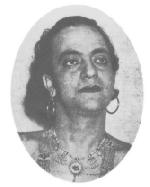| |
The
Dazzling Damsels
Sadya
Afreen Mallick
By
evening, teachers and students began to flock at the auditorium
on the first floor of the Fazlul Huq Hall. As we passed
the massive gardens bursting with flowers ranging from Dahlia,
Chrysanthemum and Marigold I held my father's hand only
to hurry up before all the seats were booked. An annual
function was arranged by the students of Dhaka University
residing at the Fazlul Huq Hall.

A girl of six or seven back then, I could feel the enthusiasm
and great excitement everywhere. A variety show was something
which everybody enjoyed, particularly at a time when there
was hardly any entertainment. As always, dance was the main
attraction of the show.
Suddenly my eyes fell on a little girl almost my age, right
inside the wings beside the stage. Her mother busily giving
her hair one last brush and fixing her hair with golden
ribbons. She was gorgeously dressed in white brocade frock,
coatie and churidaar a typical dress for Kaththak dancers.
Her sparkling eyes laden with kajal, she looked just like
a princess, I thought to myself. The applause was thunderous
every now and then -- clearly the audience was awestricken
by her Katthak dance. Little did I know then, that this
mesmerising performer was none other than Anjana Shaha,
now Anjana Rahman who is a well known film-star of our country.
For those who remember her, she was one of the most talented
artistes of her genre.
We were among the lucky young ones who had the opportunity
to watch the aspiring talents who performed with grace and
later became stars in the cultural arena.
I can recollect, at the then Pakistan council located somewhere
in Motijheel, a regular programme was held for talented
young boys and girls. One evening a Kaththak dancer in her
glittery dress and jewellery while whirling in a terrific
speed with the swift rhythm of the tabla, her jhumka (earrings)
and a few pieces of her jhumur from her anklet bells scattered
in all directions. We were overwhelmed by her classical
dance performance. Many of you probably remember Kajal Mahmood,
now Kajal Ibrahim who commanded deep respect as a dancer
though even she retired at an early stage.

Dance as we know developed as an art under
the patronage of the kings and emperors at the royal palaces
and courts. Given the social backdrop at that time, dancers
were often looked down upon by the conservative society.
Against all odds, even in this unfavorable
context, some educated elites worked tirelessly to popularise
this form of art.
One of the most active proponents of this performing art
was Bulbul Chowdhury. In 1938 he set up the dance institute
Oriental Fine Arts Association. Within a few years, he earned
widespread repute across Dhaka and Calcutta through his
exceptional performances. His dance drama on the World War
was widely acclaimed. One of his boldest stage performances,
“Quit India” was performed in England itself -- a direct
strike against colonialism. He passed away in 1954, but
his wife Afroza Bulbul, carried on his work through the
setting up of Bulbul Academy of Fine Arts(BAFA).
Around 1949, another great dancer Gauhar Jamil began to
monopolise the limelight. In the dance ballet, Indrer Shobha
he partnered with another stalwart of the dance world --
Raushan Jamil. After they got married in 1952, the couple
established Jago Art Center. Since then the institute has
played an important role in the development of dance in
the region. He introduced such new forms as Jeley Nritto,
Gypsy, Cha Bagan, Naga, Shaotali etc. In 1956 after the
establishment of Bulbul Academy, aspiring talents flocked
to dance institutes such as Nikkon, Jago Art Centre, Altaf
Mahmood Music Academy and Chhayanaut.
Over the years, some of the leading performers to grace
the stage were Rahiza Khanam, Laila Hasan, G A Mannan, Altamas,
Sharmin Hasan, Dalia, Kajol Ibrahim, Lubna Marium, Afroza,
Zeenat Barkatulla, Minu Billa, Shamim Ara Nipa, Sharmila
Banerjee, Shukla Sharkar, Tamanna, Deepa Khandakar, Shibly
Mohammed, Hasan Imam, Mun Mun, Momtaz, Vilayet and others.
Lubna a reputed dancer, has earned the adulation of audiences
at home and abroad. She is trained in Bharatnatyam, Monipuri
and later on in a fusion dance style which was inspired
by Tagore himself. Zeenat Barkatulla specialized on contemporary
dances, Sharmila Banerjee a dancer and choreographer is
renowned in the field of Monipuri and Rabindra Nrittyo,
Minu Billa specialised in Oddisi dances, Shukla Sarkar and
renowned Vilayet are for Bharatnattyam and Mun Mun specialised
in Kaththak. Shibly Mohammad and Nipa in Kaththak and contemporary
dance are the popular most duo. Tamanna took her training
in the field of Manipuri dance. These artists are not only
popular in their own country, but have earned international
acclaim as well.
More recently, we saw the entrance and popularity of such
performers as Sadia Islam Mou, Bijori Borkotullah, Tarin,
Ria, Ishita, Sohel, and Kabirul Islam to name a few. Many
of these artists have since moved to modeling, fashion and
drama, and continue to enthrall audiences.
The popularity of dance is borne out by its presence in
all forms of media beginning from state functions, Radio,
TV to drama, theatre, Jatra and art films. At the heart
of its appeal lies the fact that they are a reflection of
our past and present society. Famous works such as Nakshi
Kathar Matth, Mayar Khela, Chitrangoda, Hajar Tarer Bina,
Badal Borishoneye, Mahuya, Rajpoth Janopoth, Nobanno are
indicative of this -- playing out the rural life, the perennial
oppression of the innocent, the struggle between vices and
virtues and so on.
Performing arts have no doubt had a profound and explosive
impact on societal thought and ideals. It would be nearly
impossible to find an alternative to songs, drama and dance
that can similarly convey such a direct and powerful message
to inspire social awareness amongst people from all walks
of life. |


